Test: Case IH Puma 175 CVX Drive Stage V
Farm trader takes a close look behind the wheel of the Case IH Puma 175, putting it through its paces in some wet winter conditions.
 |
|
Fresh styling adds a modern touch
|
Case IH has been one of the leading agricultural brands in New Zealand for several years, from tractors and combine harvesters to balers and sprayers. Recently celebrating its 175th year in farm equipment production, a special edition Puma 175 was released. Five years on from that, the Stage V Case IH Puma short wheelbase (SWB) has landed in the country. We look at the changes and features that further enhance the already proven Puma series.
The Stage V SWB Puma is the first of the Puma series to sport the latest new Case IH livery that the Optum series introduced in the back end of 2015. This new design updates the familiar bonnet that has typically been the face of Case IH. This aggressive styling not only looks good but also provides more lights, adding to the 360-degree light package that’s necessary these days for operators to achieve at a high-quality level. A daytime running light has been added to this design, again modernising the tractor and adding another level of class.
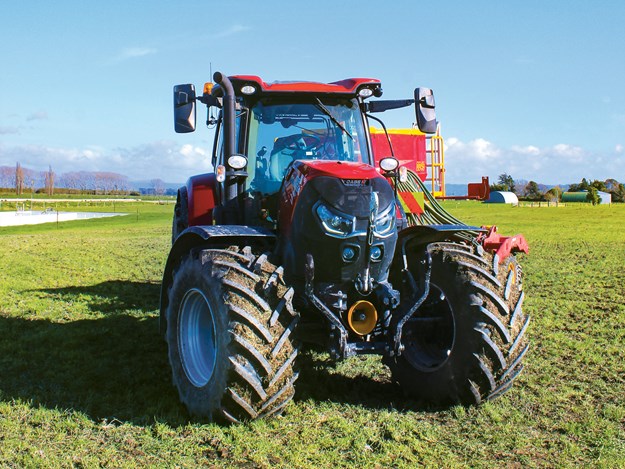 |
|
Heavy-duty factory front linkage
|
Service intervals for the Stage V engine are pushed out to 750 hours. This is a
150-hour increase over previous models, enabling more valuable time in the field. When it comes to daily servicing, it’s all easily done from ground level with a dipstick for the engine and a sight glass on the rear of the transmission. The bonnet swings up extremely high and the radiators pop out for easy cleaning. The new style bonnet also has larger panels that clip in underneath it. These seal the engine bay better than previous models, reducing the chance of foreign objects working their way in.
Specs and options
The short-wheelbase Puma offers three models with CVX Drive transmission.
A Puma 150, 165, and 175, each producing up to 175, 190, and 204hp respectively. To make it easier for the customer to choose the right level of extras required for their operation, a simple choice from the ‘Classic’ or ‘Ultimate’ spec is available.
 |
|
Bonet opens high for servicing
|
Not requiring much explanation, the Classic option has all the necessary components whereas the Ultimate has all the extras from the hydraulic top link and automatic stabiliser arms all the way to leather seats, floor mat, and full LED light package.
Classic or Ultimate, they all feature the same reliable and proven 6.7-litre FPT engine that’s seen in the LWB (long wheelbase) Puma series. Case IH continues with its easy-to-understand horsepower rating matching with the number on the bonnet being what comes out of the engine at the rated power. All models power boost approximately 25hp under certain criteria. A 330-litre diesel tank along with a 48-litre AdBlue tank holds the necessary amount of fuel to conduct a long day’s work while being Stage 5 emissions compliant.
The hydraulic system on SWB Puma uses the same oil as the transmission. This is a similar design to most powershift tractors and saves on weight and space. The Classic spec tractor runs a 140-litre per minute hydraulic pump, but if the Ultimate spec has been chosen, then a larger 160-litre per minute pump is supplied.
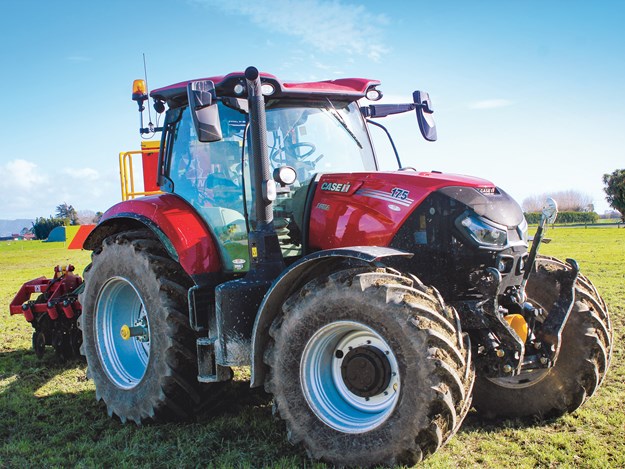
A maximum of four electronic remotes are available at the rear with three at the front through a mid-mount valve. The rear link arms have a lift capacity of 8257kg and 3569kg at the front linkage. Both linkages are Cat 3 linkage. If the front linkage and PTO option is selected, the viscous fan is replaced for electronically reversible fan as standard. This comes in handy when operating triple mowers and for chores such as stacking, as with the simple push of the button, the blades are reversed and all foreign matter is blown off the grills allowing fresh air back in, keeping the tractor running at peak performance. The suspended front axle works well with a bit of weight on it. The front hubs also house the front axle brakes internally. This reduces load on other components and applies the braking where needed. This is also why the front hubs on some Case IH tractors are larger than other brands.
Performance/test/cab
Our test tractor was the classic spec version and looked the part sitting on the 710/60r38s and 600/60r28 tyres. We hooked it up to a Duncan DD45 drill and despite the heavy rain Whakatane had endured, we were able to get in and drill a paddock without making any mess. The specific hitching up buttons on the armrest panel made hitching up easy, as the hitch was in full control and acted in the same way pressing the mudguard buttons would (these are and are located in a great place for this action).
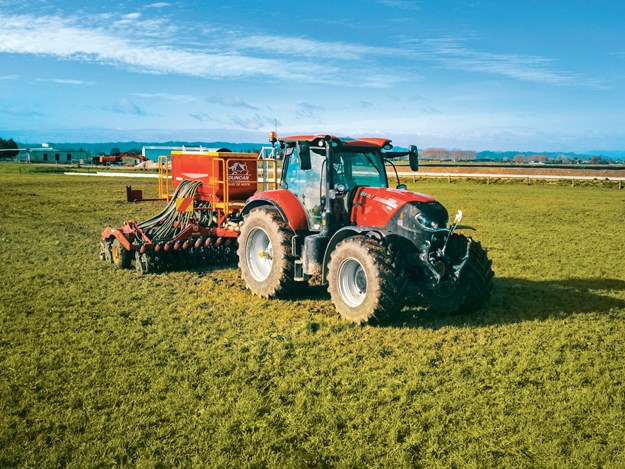 |
|
Comfortably pulling the Duncan drill
|
Something I particularly enjoy about Case IH tractors is that if the linkage is in the up position, moving the max height dial down will lower the linkage automatically. The only downfall is if hitching up from outside, the linkage won’t go above the set max height.
Getting into the four-pillar cab, the familiar multi-controller armrest and Case IH A-pillar dash stand out. The dash located on the A-pillar is a highlight, as the operator doesn’t have to look through the steering wheel to see the basic machine values. Plus, it’s in your field sight and as you look from the windscreen to your implement behind you. For the test, I wanted to make full use of the RTK autosteer built into the tractor. With an array of information able to be stored on the tractor, such as customer, farm, field, and crop, selecting the paddock we were in wasn’t difficult. Setting up the guidance was rapid, too. Multiple guidance patterns were available to choose from but guidance from heading was the most suitable choice for the task at hand. Within seconds the tractor was steering itself and painting pictures on the AFS 700 screen.
.jpg) |
|
No shortage of lights with the new styling
|
The 175 pulled the drill with ease at minimal wheel slip, leaving an extremely tidy finish especially after drilling the paddock, skipping every second run. The only part
of the autosteer system that was difficult was the button on the armrest that requires an unnecessary move of the arm to activate it. However, this could be resolved if I took the time to program the headland management sequence.
Controls
The armrest also provides quick and easy access to tractor functions without looking for them. All functions are positioned in their relevant location on the armrest. The
multi-controller has functions applying to speed, direction, linkage, and hydraulics. Only one spool is configurable to the multi-controller, which is getting minimal for demanding operations. The linkage buttons are always selected to do the rear linkage, but, if the button on the rear is pressed at the same time, it does the front linkage. This is an effective way to get more usability out of the same buttons.
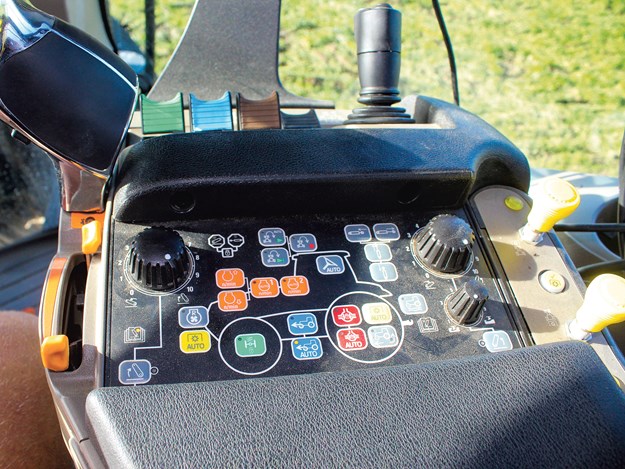 |
|
Familiar Case IH layout clearly laid out
|
A feature that’s easily missed on the multi-controller is the anti-jack-knife feature. This is activated by holding the forward button. While holding the button, the transmission is essentially locked at that speed and allows the operator to press the brakes, and only the trailer brakes get activated. This essentially stretches the unit and pulls straight again. An exhaust brake is also present on both Classic and Ultimate spec tractors. This pedal is to the left of the clutch and provides an impressive amount of braking force.
A headland management button (also on the multi-controller) means the operator can easily program a headland sequence by either recording it as it gets done or programming through the AFS Pro 700 screen. User-friendly, the screen features one main menu to access all hydraulic settings, ISOBUS, machine counters, fuel, and overall performance. Each menu is well labelled and makes the most of the full-colour touchscreen. Six run screens and a left-hand column are available for programming and renaming. From tractor data to field and autosteer information, it can all be customised to suit operator preference, as well as having the ability to be saved under a machine layout. The AFS 700 screen is simple to use if just jumping into the tractor but has enough technology packed into it to keep the most pedantic operator happy with the level of customisation.
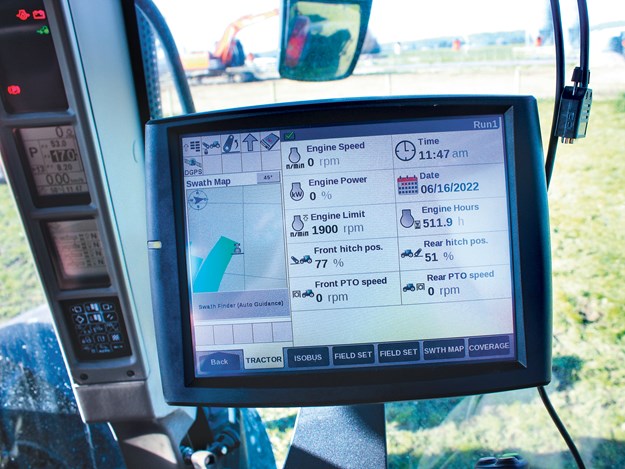 |
|
1/6 fully customisable run screens. Quick, easy access to all aspects of the machine.
|
Rear remotes are well coloured inside and outside the cab. An enjoyable feature on these later models is the reconfigurable valves. This allows the operator to reassign the valves to a different switch to suit the specific operation and allow greater operator comfort. The in-cab levers do, however, require a significant amount of pressure to click into their constant pump state and even more to go into the float setting. A simple button on the multi-controller armrest changes between the levers and the joystick without having to do it all through a computer screen, which simplifies things for the operator.
Power and performance
As for the size and power, the 175 CVXDrive is nimble and perky. With no shortage of power, it didn’t hesitate with the drill on the back. Turning at headlands was no issue either, being able to swing from run to run if needed. It would comfortably handle a set of medium-sized triple mowers or combination balers. A point I enjoy about Case IH tractors is they allow side brakes to be operated whenever needed. To combat any mistakes on road, they have a sensor to tell whether they are locked or unlocked. If locked, the tractor’s speed is limited to 40kph, which is also part of TMR regulations.
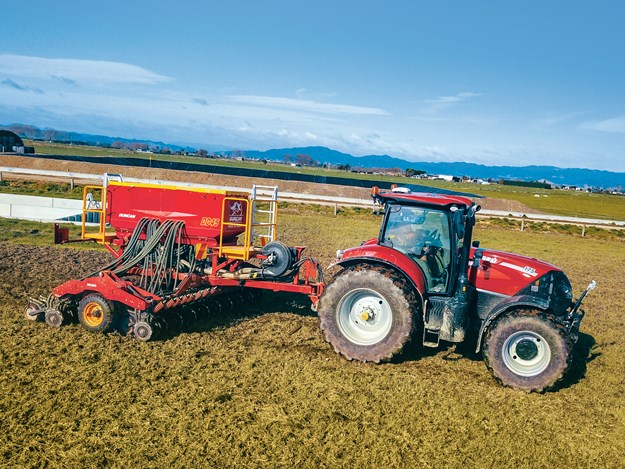 |
|
Four-pillar cab gives good visibility
|
The control of ground speed is an exceptional part of the CVXDrive transmission. Having three max speeds, clearly displayed on the dash, provides an easy pre-set speed to switch to no matter the operation. Each speed is set individually by the operator via a scroll wheel on the multi-controller. For example, when we were drilling, the lowest speed was set to 8.3kmph as the drilling speed, the middle speed was set to 17kmph for headland turning, and the top speed was set to 53kmph for road travel. This allows the operator to be more precise and efficient being able to adjust on the move without the need to go into the screen.
The CVXDrive transmission in the SWB tractors is a two-pack transmission. This essentially means it has a low gear for slow and hard pulling work and a high gear for faster work and road travel. This automatically changes between the speeds of 10 and 20kmph, reducing operator fatigue and wear on components, as the tractor decides when it needs to change.
Part of the CVXDrive package, an electronic park lock is standard across all models. This applies itself when the operator leaves the seat and after 90 seconds of being stationary. Engaged and released through the shuttle control lever, it’s user-friendly as the one movement does two things. Active hold is also a feature I enjoy on the CVXDrive transmission. This holds the tractor stationary on any slopes with no need to apply pressure on the brakes. This eliminates another task that the operator would have had to do.
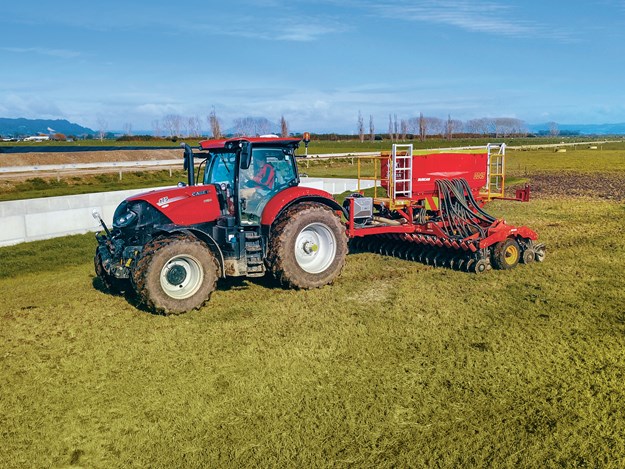 |
|
Compact frame for the 200hp it produces
|
Another part of the multi-controller armrest is the split throttle design. Two sliders reside on the armrest: the left being the minimum engine revs and the right being the maximum. The tractor will work between these set values. If the minimum is set higher than the maximum, the engine will hold the minimum and as the load increases, the ground speed will stay the same until it hits the maximum rev setting. From there, it will reduce ground speed. Despite being the Classic spec machine, the cab was surprisingly comfortable and well laid out.
All controls were within reach and there was lots of room between the seat and steering wheel. The dash design is at a great angle and lined up perfectly with the exhaust, providing more visibility. I would like to see some more room behind the seat to allow more storage. The colour scheme of the interior is basic but good, as it hides dirt well and all surfaces are easy to clean. The top compartment to the right of your head has the radio and aircon along with some empty slots for CB radios.
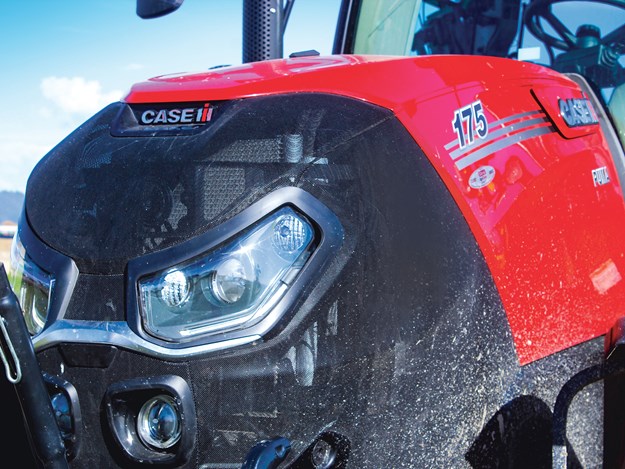 |
|
New face for Case IH: extra work lights and running lights
|
The fridge on these Pumas is great, along with the aircon. The big slot in front of the steering wheel is perfect for keeping food and drinks cold during the long scorching summer days. The only issue is fighting the urge to eat it all before 10am. If you’ve managed to not eat your food first thing in the morning and make it till after dark, the LED lights supply a great amount of light to see all your surroundings. However, the front cab lights have always bugged me slightly, as the extreme right one shines onto the exhaust and mirror causing unnecessary glare into the cab. This can be turned to reduce it, but it’s still not optimal positioning. The large wide-angle mirrors make reversing and navigating gateways a breeze. The cab on the 175 is quiet and engine and transmission noises minimal.
Summary
With all basic functions placed at your fingertips, the Stage V Case IH Puma 175 CVXDrive is easy for new operators to get in and go. The AFS 700 screen adds an extra element for seasoned operators to customise and adjust parts of the machine to suit them better. With plenty of power matched with the CVXDrive transmission, the right speed is always achieved. Aided by the speed control along with the split throttle design, setting the tractor up for any task is remarkably simple and operator friendly.
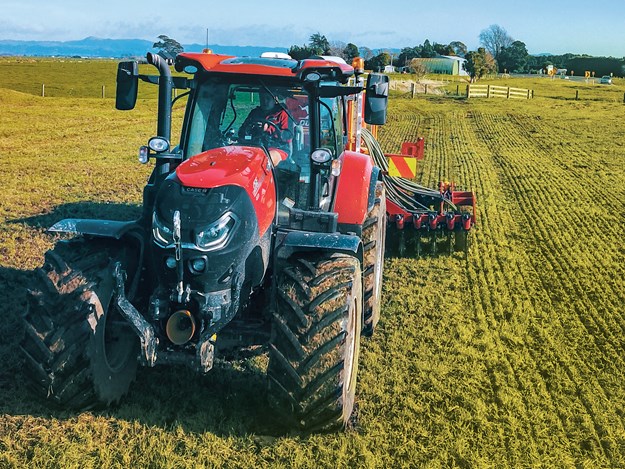 |
|
RTK autosteer lines the drill up perfectly, allowing Dan to get the photos with the drone
|
There’s room for improvement on minor cab details that I expected to be on this model, and I’m sure it’s in the pipework as larger models have rectified these issues already. Suited to large farmers and contractors, there’s a spec range to suit the needs of all businesses. Extreme manoeuvrability for a tractor capable of putting out more than 200hp through the compact frame, with precise control over the engine, the 175 CVXDrive is a great size for small and large implements.
Case IH Puma 175 CVX Drive Stage V Specifications
| Engine size | 6.7L |
| Diesel tank | 330L |
| AdBlue tank | 48L |
| Max speed | 50kmph |
| Hydraulic pump capacity | 140L/min |
| Valves | 4 x rear remote valves |
| Lights | 8 led work lights and 4 halogen bonnet lights |
| In-cab | AFS 700 Touchscreen, ISOBUS compatible |
|
Rear lift capacity |
8257kg |
|
Front lift capacity |
3569kg |
| Alternator amps | 200amps |
| Wheelbase | 2789mm |
| Working weight | 7105kg |
| Max permissible weight | 10,500kg |
| Total Height | 3026mm |
| PTO speeds | 540, 540e, 1000 |
Pros
- New bonnet with extra lights
- Slots for CB radios
- LED lights
- Powerful and reliable FPT 6.7L engine
- Simple, straightforward layout for a CVT tractor
- Great speed control through three max speeds
- No high/low to change
- Screen is easy to navigate
- Large fridge
- Large wide-angle mirrors
- Electronic park lock
Cons
- Hydraulic spools are hard to push
- Multi-controller functions are limited and getting outdated
- Cab storage is limited
- Front windscreen wiper doesn’t cover much area
Find new and used farm machinery for sale in NZ
Keep up to date in the industry by signing up to Farm Trader's free newsletter or liking us on Facebook











.jpg)
.jpg)
.jpg)



